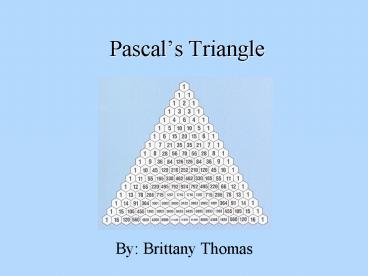Pascal - PowerPoint PPT Presentation
Title:
Pascal
Description:
Pascal s Triangle By: Brittany Thomas History & Structure Pascal's Triangle was originally developed by the ancient Chinese, but Blaise Pascal was the first person ... – PowerPoint PPT presentation
Number of Views:66
Avg rating:3.0/5.0
Title: Pascal
1
Pascals Triangle
- By Brittany Thomas
2
History Structure
Pascal's Triangle was originally developed by the
ancient Chinese, but Blaise Pascal was the first
person to discover the importance of all of the
patterns it contained. The tip of the triangle is
always a one, as well as all the numbers on the
outermost diagonals. To get the other numbers,
you take any two consecutive numbers and add
them. They create the number in between them in
the next row down. The tip of the triangle is
considered the 0th element, the second row is the
1st element, and so on.
3
Sierpinskis Triangle
The pattern Sierpinskis Triangle is formed when
you clearly distinguish the odd numbers from the
evens. For example, in this picture, the odd
numbers were colored black and the even numbers
remained white. The pattern creates more and more
smaller triangles as you color more numbers.
4
The sum of the rows
The sum of the rows arent just any random
numbers. They also form a pattern. The sum of a
row is equal to 2n when n equals the number of
the row. As you can see from the diagram, 2 to
the 0th power equals 1. The 0 represents that it
was the 0th row and in that row there is only a
one 20 equals one .
20 121 11 222 121 423 1331
824 14641 16
5
Square numbers
A certain type of numbers in this triangle are
square numbers. Square numbers are located in the
third diagonal. A Square number is the sum of
any two consecutive numbers in the third row of
the triangle. Notice when all the circled numbers
in the picture are added together, they make a
square number. For example, 134 and 61016. 4
and 16 are both perfect squares.
6
Hockey Stick Pattern
If a diagonal of numbers of any length is
selected starting at any of the 1's bordering the
sides of the triangle and ending on any number
inside the triangle on that diagonal, the sum of
the numbers inside the selection is equal to the
number below the last number of the selection
that is not on the same diagonal
itself. 162156 84172884210462924
1716112 13
7
Magic 11s
Another pattern discovered within the triangle is
the Magic 11s. The idea behind this pattern is
that you need to take each row and convert it
into a single number. The number is equal to 11
to the nth power or 11n when n is the number of
the row the multi-digit number was taken from.
For example, the third row (113) consists of a
1,3,3, and a 1 113 equals 1331.































